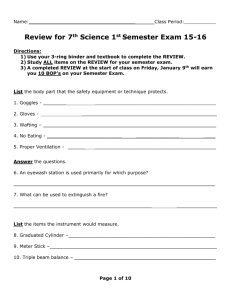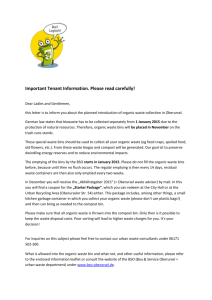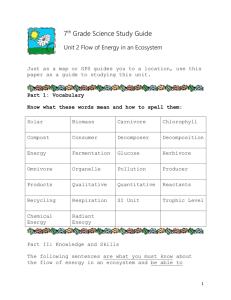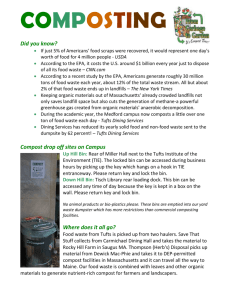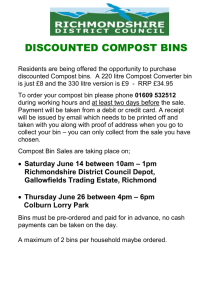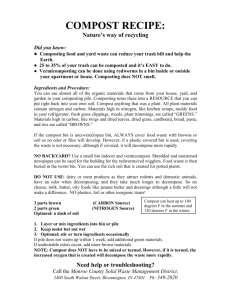Study
advertisement
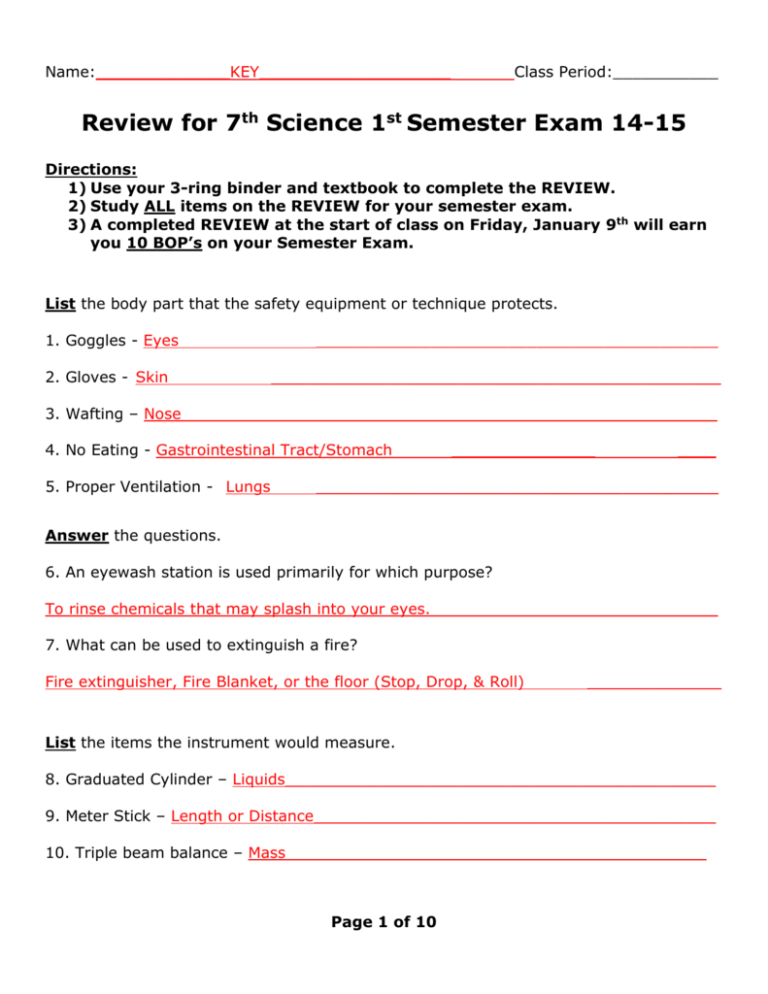
Name:______________KEY____________________ Class Period:___________ Review for 7th Science 1st Semester Exam 14-15 Directions: 1) Use your 3-ring binder and textbook to complete the REVIEW. 2) Study ALL items on the REVIEW for your semester exam. 3) A completed REVIEW at the start of class on Friday, January 9th will earn you 10 BOP’s on your Semester Exam. List the body part that the safety equipment or technique protects. 1. Goggles - Eyes 2. Gloves - Skin __________________________________________ _______________________________________________ 3. Wafting – Nose________________________________________________________ 4. No Eating - Gastrointestinal Tract/Stomach 5. Proper Ventilation - Lungs _______________ ____ __________________________________________ Answer the questions. 6. An eyewash station is used primarily for which purpose? To rinse chemicals that may splash into your eyes.______________________________ 7. What can be used to extinguish a fire? Fire extinguisher, Fire Blanket, or the floor (Stop, Drop, & Roll) ______________ List the items the instrument would measure. 8. Graduated Cylinder – Liquids_____________________________________________ 9. Meter Stick – Length or Distance__________________________________________ 10. Triple beam balance – Mass____________________________________________ Page 1 of 10 Answer the questions. 11. In an experiment, what is the variable that you can change? Independent Variable_____________________________________________________ 12. In an experiment, what is the variable being measured? Dependent Variable ___________________________________________________ 13. In an experiment, what is the variable that stays the same through the entire experiment? Constants____________________________________________________ 14. Scientists use their prior knowledge and experience to: form a hypothesis _______________________________________________________ 15. What can be used to analyze data? Table, chart, or graph ________________________________________________ 16. Define Observations: Bits of information you gather with your senses_________________________________ Identify: Independent Variable, Dependent Variable, & Constant in an experiment. Label each piece of laboratory equipment. 17. 19. 21. _____ Beaker ____ 18. ___Erlenmeyer Flask__________ ____Balance______ 20. _____Graduated Cylinder_______ ______Florence Flask Page 2 of 10 Answer the questions. 22. What happens to the temperature in a compost bin during decomposition? The temperature increases_________________________________________________ Interpret: Be able to interpret graphs. 23. What happens to the organic matter during decomposition? It is broken down into useful compounds______________________________________ 24. What energy transformation occurs as biomass decays in a compost bin? Chemical to thermal______________________________________________________ 25. What materials in a compost bin will be recycled into soil-enriching nutrients? Biomass: Material from living or recently living organisms Examples: Newspaper, fruit, & vegetables______________________________________________________________ 26. During decomposition, what does the bacteria in the soil do? It changes nitrogen into a useful form________________________________________ 27. Where does a herbivore get it nutrients from in its habitat? By eating plants that get them from the soil___________________________________ 28. In a compost bin, what process leads to the cycling of organic matter? Decomposition__________________________________________________________ 29. What is a tropism? A plants response to an external stimulus_____________________________________ 30. What is the definition of the prefix GEO? Earth__________________________________________________________________ 31. What is the definition of the prefix HYDRO? Water__________________________________________________________________ 32. What is the definition of the prefix PHOTO? Light__________________________________________________________________ Page 3 of 10 33. What is the definition of the prefix THIGMO? Touch__________________________________________________________________ 34. What gas do plants release as a result of photosynthesis? Oxygen________________________________________________________________ 35. What energy transformation occurs during photosynthesis? radiant energy into chemical energy__________________________________________ 36. Glucose helps maintain life on our planet by storing what type of energy? chemical energy_________________________________________________________ 37. The diagram provided illustrates the process of photosynthesis, including the substances used by and produced by plants. What is the identity of the chemical represented by the question mark in the diagram? Glucose________________________________________________________________ 38. Show how energy flows through a food chain? Sun » Producers » Herbivores » Carnivores____________________________________ Identify: Producers, Consumers, Herbivores, & Carnivores in a Food Chain or Web. 39. Define Producer: provides the primary source of energy for all other organisms_____________________ 40. Define Consumer: gains energy by eating other living things_____________________________________ Page 4 of 10 41. Define Herbivore: Animals that eat only plants or plant products__________________________________ 42. Define Carnivore: Animals that eat other animals______________________________________________ 43. What element is found in all organic compounds? Carbon________________________________________________________________ 44. What is Denitrification? the process by which bacteria return nitrogen gas to the atmosphere_______________ 45. What is the difference between a primary, secondary, and tertiary consumer? A primary consumer gets their energy by feeding on producers in the food chain,______ secondary consumers get their energy by feeding on primary consumers (herbivores),__ and tertiary consumers get their energy by feeding on secondary consumers._________ Identify: the paths that energy would flow through an ecosystem diagram. An example of an ecosystem diagram is below. Page 5 of 10 46. A diagram is provided. Which portion of the diagram represents the level with the most available energy? Producers______________________________________________________________ 47. Why are bacteria so important to the nitrogen cycle? bacteria change the nitrogen into a usable form________________________________ Identify: Using a portion of the Periodic Table or an illustration of chemical compounds be able to identify if a compound is organic or inorganic. 48. What must a compound contain to be organic? C Carbon_______________________________________________________________ Page 6 of 10 49. The table provides information on the function of different digestive structures. Which of the digestive structures in the table can cause a chemical change to occur? ___Stomach____________________________________________________________ 50. What are Carbohydrates made of? a chain of simple sugars, such as glucose____________________________________ List the smaller molecule that each large molecule is broken down into by digestion. 51. Lipid to Fatty Acid_____________________________________________________ 52. Carbohydrate to Sugars________________________________________________ 53. Protiens to Amino Acids________________________________________________ 54. What is a chemical change? It involves a change in the identity or chemical composition of a substance.__________ 55. List examples of chemical changes during digestion? Protein is broken down into amino acids in the stomach and Saliva breaking down starch into carbohydrates_______________________________________________________ 56. What is a physical change? It involves changes to the form of a substance, but not to its chemical identity. 57. List examples of physical changes during digestion? Teeth chewing food to make it easier to swallow and Food gets squeezed into a different shape when passing through the esophagus.___________________________________ Page 7 of 10 58. What are indicators a new substance has been formed? Gas production, Solid formation, and sometimes color/temperature changes. 59. What is the formula used to calculate work? Work = Force X Distance___________________________________________________ Three situations in which force is applied to a box are illustrated. Describe what work is being done in each situation and how they relate to each other. 60. Situations 1: The same amount of work is done in Situations 1 and 3.____________ 61. Situation 2: No work is done_____________________________________________ 62. Situation 3: The same amount of work is done in Situations 1 and 3._____________ 63. When an object is lifted directly from the ground rather than moved with an inclined plane, what will be increased? The force needed to move the object_________________________________________ 64. No work is said to be done in a situation where a force is applied to an object & the object does not move__________________________________________________ Page 8 of 10 List examples of these Simple Machines 65. Inclined Plane: Ramp, ladders, stairs_____________________________________ 66. Wedge: Axe Head, staple, door stop______________________________________ 67. Screw: Screw, jar lid, drill, bolt _________________________________ 68. Wheel and Axle: Bike wheel, electric fan, merry go round____________________ 69. Lever: Crowbar, door handle, light switches, hinges_______________________ Answer the questions. 70. Define Newton’s 1st Law: “Law of Inertia”- objects in motion stay in motion, objects at rest stay at rest, unless acted on by an unbalanced force.______________________ 71. Define Newton’s 2nd Law: “Law of Force” - Force= Mass x Acceleration__________ ______________________________________________________________________ 72. Define Newton’s 3rd Law: “Law of Action-Reaction” - For every action, there is an equal but opposite reaction._______________________________________________ 73. Animals can move as a result of what energy conversion? Chemical Energy » Mechanical Energy_______________________________________ 74. What happens to the energy obtained by an organism when it consumes food? It is transformed into other forms of energy__________________________________ 75. Mammals maintain their body temperature as a result of what energy conversion? Chemical Energy » Thermal Energy_________________________________________ 76. Define Turgor Pressure: Force of water molecules against the cell wall that allows plants to stand up straight. 77. When a plant performs photosynthesis, the radiant energy of the Sun is stored as what type of energy? Chemical Energy________________________________________________________ Page 9 of 10 Describe the types of energy. 78. Radiant: Energy from the sun __________________________________________ 79. Chemical: Energy stored in the bonds of molecules_________________________ 80. Mechanical: Energy of motion or position_________________________________ 81. Electrical: Energy carried by the flow of an electric current___________________ 82. Define Diffusion: the movement of particles from areas of high concentration to areas of low_________ concentration. This process rids the cell of waste products and brings nutrients into the cell._______________________________________________________________ Interpret Diagrams of Osmosis. Be able to identify the direction in which water molecules will move. 83. Define Atom: The smallest particle of an element maintaining the chemical identity of that element___ 84. Define Compound: A pure substance made of two or more kinds of atoms bound together_______________ 85. Define Element: A pure substance composed of the same type of atom throughout__________________ Page 10 of 10
